Please Wait While Photos Load !
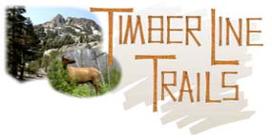
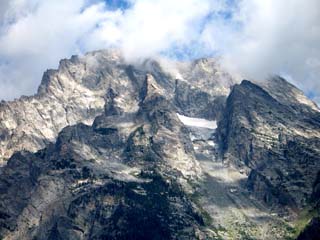
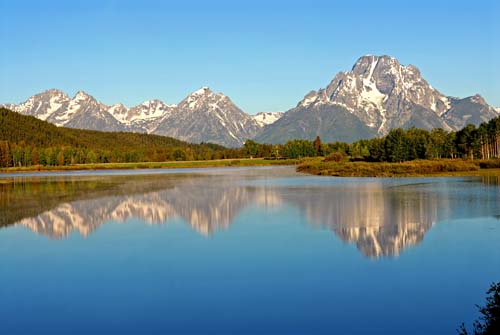
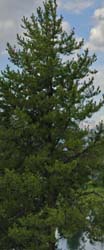
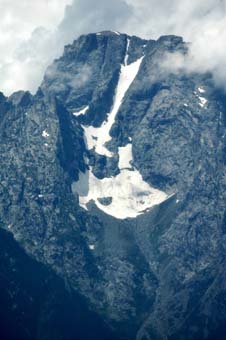
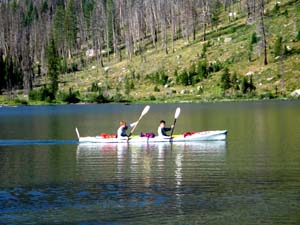
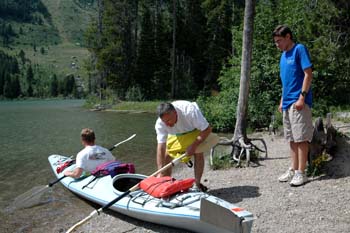
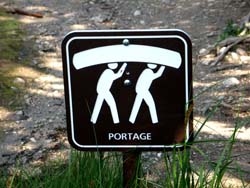
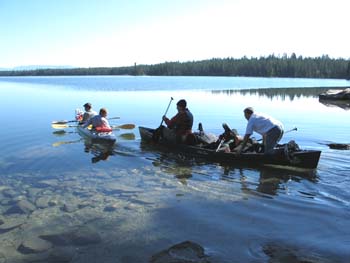
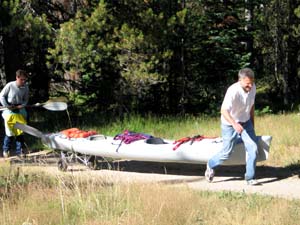

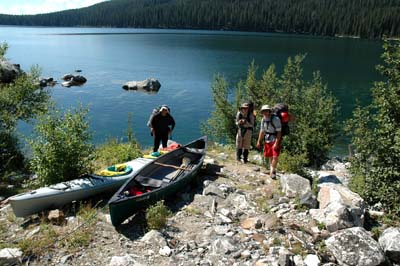
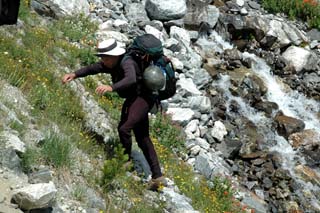
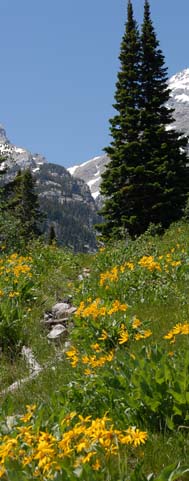
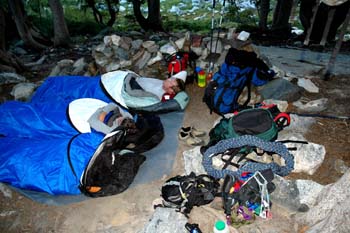
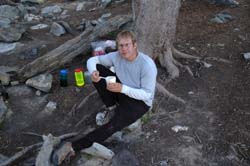
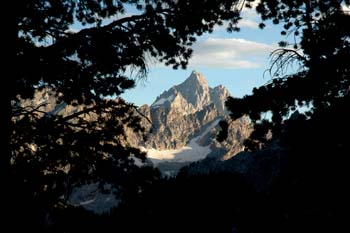
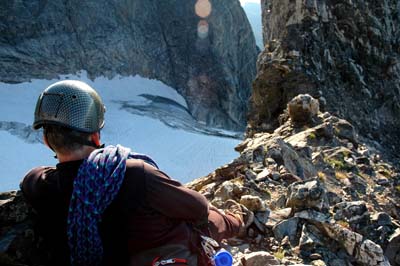
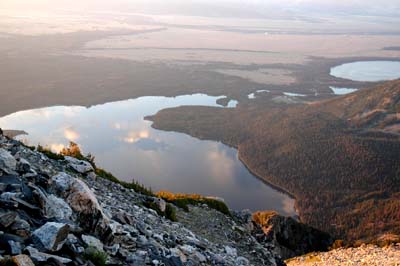

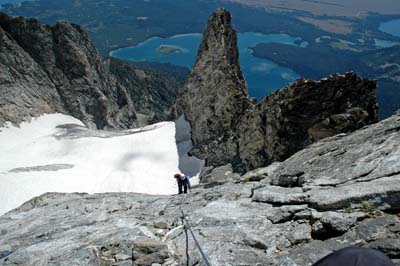
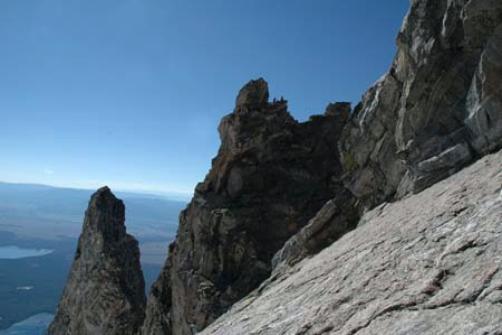
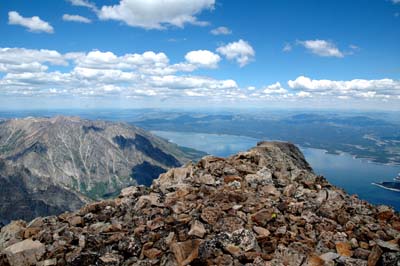
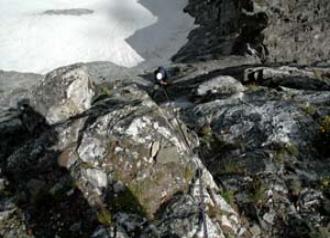
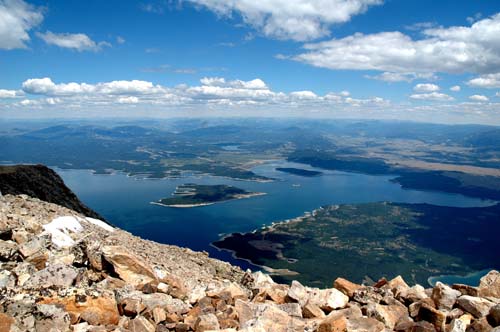
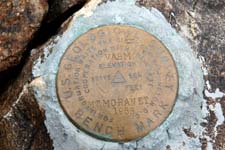
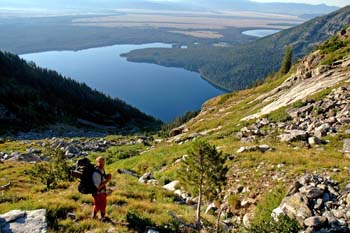

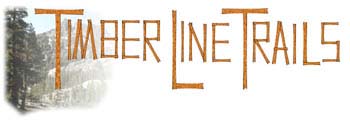
Grand Teton National Park - Climbing Mount Moran
Teton Links
Teton Home
Climb The Grand
Climb Mt Moran
Teton Home
Climb The Grand
Climb Mt Moran
| From the north and the northeast, Mount Moran dominates the scene. It is also one of the most photographed mountains in the park. Above, you see it photographed from the famous "Oxbow Bend" vantage point. For climbers, Mount Moran is second only to the Grand Teton. An article in Scientific American on March 30, 1918 stated, "The summit has never been attained and probably never will, as the last 3000 feet of the mountain are sheer perpendicular walls of rock" Well, Mountaineer's can't stand statements such as that, and the race was on for the summit. Moran was finally conquered on July 27, 1922 by Hardy and Ben C. Rich along with Bennet McNulty. Moran sports no less than five glaciers, and with its numerous ridges and couloirs there are many opportunities for climbers and mountaineers to test their abilities. There are no easy routes to the summit and technical climbing skills are required if you want to reach the top. The summit is capped by a thin layer of sedimentary sandstone, and measures no less than 600 by 1600 feet for a total area of 15 acres. We choose the 5.5 rated CMC route for our ascent. It affords good rock and exciting climbing, and we found ourselves well pleased with the choice. |
The incredible massif of Mount Moran is
impressive indeed. Any climber who ventures on
the slopes of Moran will instantly feel the scale of
this impressive mountain.
impressive indeed. Any climber who ventures on
the slopes of Moran will instantly feel the scale of
this impressive mountain.
The Skillet Glacier on Mount
Moran is the most recognizable
glacier as viewed from the Jackson
Lake vantage point, and the most
popular snow and ice climb on the
mountain.
Moran is the most recognizable
glacier as viewed from the Jackson
Lake vantage point, and the most
popular snow and ice climb on the
mountain.
Mike giving instructions on proper water craft
procedures a couple of days in advance so that all
would go well on approach day.
procedures a couple of days in advance so that all
would go well on approach day.
Matt and Sean heading out on String Lake for
Mount Moran. It is much easier to canoe or
kayak to the base of the climb than to
bushwhack along the heavily vegetated banks
of the lakes.
Mount Moran. It is much easier to canoe or
kayak to the base of the climb than to
bushwhack along the heavily vegetated banks
of the lakes.
After completing the paddle along
String Lake, there is a small portage of
about a quarter mile in length that is
required for people with canoes and
kayaks in order to connect with Leigh
Lake. But this effort is nothing in
comparison to hiking through heavy
brush (along the banks of Leigh Lake)
in order to get to the base of Mt Moran.
String Lake, there is a small portage of
about a quarter mile in length that is
required for people with canoes and
kayaks in order to connect with Leigh
Lake. But this effort is nothing in
comparison to hiking through heavy
brush (along the banks of Leigh Lake)
in order to get to the base of Mt Moran.
Mike (right) carrying the front of the kayak
along the quarter mile portage. Fortunately,
the kayak has wheels on the back making it
easy for Sean in the rear.
along the quarter mile portage. Fortunately,
the kayak has wheels on the back making it
easy for Sean in the rear.
After the portage, we set off on Leigh Lake in the early
morning hours. Leigh Lake, is a beautiful lake, and
paddling on it was a treat. It is by far the larger of the
two paddling journeys when compared to String Lake,
but I found it to be one of the highlights of the entire
trip.
morning hours. Leigh Lake, is a beautiful lake, and
paddling on it was a treat. It is by far the larger of the
two paddling journeys when compared to String Lake,
but I found it to be one of the highlights of the entire
trip.
After about an hour of paddling, we arrive at the base of
Mount Moran. Make sure to secure your canoe or kayak to
something solid just in case of heavy winds or some other
mishap. You do not want to return and find your craft adrift in
the lake far from shore.
Mount Moran. Make sure to secure your canoe or kayak to
something solid just in case of heavy winds or some other
mishap. You do not want to return and find your craft adrift in
the lake far from shore.
Mike working his way up the steep slopes of
Mount Moran. Definitely a whole lot of effort is
required to carry a pack up this portion of the
climb.
Mount Moran. Definitely a whole lot of effort is
required to carry a pack up this portion of the
climb.
View of the Grand Teton from the CMC camp. One of
the things I looked forward to on the climb, was the
stay at the CMC camp. It has the reputation of being
one of the best high camps in all the range. I found the
camp to be quite satisfactory.
the things I looked forward to on the climb, was the
stay at the CMC camp. It has the reputation of being
one of the best high camps in all the range. I found the
camp to be quite satisfactory.
Matt enjoying dinner the night before
the climb. Getting food down before
turning in is very important in the
mountains. It helps maintain ones body
heat for the night out, and provides for
much needed energy the next day.
the climb. Getting food down before
turning in is very important in the
mountains. It helps maintain ones body
heat for the night out, and provides for
much needed energy the next day.
All chores done, and Matt and Sean turn in for the
night. All gear is ready for the next day. We always
take time out and get our smaller climbing packs
ready for the next day, so we can get an early
pre-dawn start. It is vitally important to get an early
start so you will have the maximum number of hours
available to complete your climb.
night. All gear is ready for the next day. We always
take time out and get our smaller climbing packs
ready for the next day, so we can get an early
pre-dawn start. It is vitally important to get an early
start so you will have the maximum number of hours
available to complete your climb.
Sunrise high above the CMC camp provides climbers with
beautiful views of Leigh Lake (the large lake in the left and
center foreground).....Jenny Lake (the round lake in the upper
right corner), and String Lake (the small ribbon lake between
Leigh Lake, and Jenny Lake). This vantage point gives us a
great view of our earlier paddling journey.
beautiful views of Leigh Lake (the large lake in the left and
center foreground).....Jenny Lake (the round lake in the upper
right corner), and String Lake (the small ribbon lake between
Leigh Lake, and Jenny Lake). This vantage point gives us a
great view of our earlier paddling journey.
Mike looking down on the "Falling Ice Glacier". Thankfully, we
did not have to ascend this glacier. They don't call it falling for
nothing. Every now and then we could hear chunks of ice peel
off the frontal portion of the glacier. This would be enough to
put the fear into any climber in it's path.
did not have to ascend this glacier. They don't call it falling for
nothing. Every now and then we could hear chunks of ice peel
off the frontal portion of the glacier. This would be enough to
put the fear into any climber in it's path.
Here we see Sean climbing the steepest section of the CMC
face. In the rear right portion of the photo, is the infamous
Drizzlepuss, which is the crux of the climb. The first challenge
on Drizzlepuss is getting down, and the second is getting back
up on your return to the CMC camp after you summit.
face. In the rear right portion of the photo, is the infamous
Drizzlepuss, which is the crux of the climb. The first challenge
on Drizzlepuss is getting down, and the second is getting back
up on your return to the CMC camp after you summit.
As mentioned above, Mount Moran has a large summit
plateau. What you see here is just the tip of the iceberg.
plateau. What you see here is just the tip of the iceberg.
Beautiful view of Jackson Lake from the summit of Mount Moran.
Certainly one of the many rewards of mountaineering is the wonderful views
you get from the summits. They are unequalled anywhere on earth, and no
photograph can take the place of being there.
Certainly one of the many rewards of mountaineering is the wonderful views
you get from the summits. They are unequalled anywhere on earth, and no
photograph can take the place of being there.
Sean on one of the many rappels that are required
for descending the CMC face.
Always take special care when setting up anchors
and belay points. Never think that just because you
made it to the top that the difficulties are over.
Always keep in mind that more climbers die on the
descent than on the ascent.
for descending the CMC face.
Always take special care when setting up anchors
and belay points. Never think that just because you
made it to the top that the difficulties are over.
Always keep in mind that more climbers die on the
descent than on the ascent.
To the left is a photo of
the Mount Moran bench
marker. 12.605 Feet !
the Mount Moran bench
marker. 12.605 Feet !
Matt nearly back down to Leigh Lake.
It is always a wonderful feeling to gain the safety of
lower elevations.
It is always a wonderful feeling to gain the safety of
lower elevations.
If you look carefully, you can see two climbers on the center rock structure.
This structure is called "Drizzlepuss" by the first climbers who found themselves
in a light rain while climbing on it. Once you gain the top, you will get your first
view of the CMC face. "The Climber's Guide to the Teton Range" by Leigh N.
Ortenburge & Reynold G. Jackson describe the view this way: "Once on top of
Drizzlepuss, you are presented with a terrifying view of the CMC route, which
goes more or less up the middle of the face to the left (south)of the black dike;
most of the slabs appear impossible. However, take heart and down climb the
very steep west face of Drizzlepuss toward the notch separating it from the
main east face of Mount Moran." Well, they are right, you need to take heart
because the climb opens up as you proceed.
This structure is called "Drizzlepuss" by the first climbers who found themselves
in a light rain while climbing on it. Once you gain the top, you will get your first
view of the CMC face. "The Climber's Guide to the Teton Range" by Leigh N.
Ortenburge & Reynold G. Jackson describe the view this way: "Once on top of
Drizzlepuss, you are presented with a terrifying view of the CMC route, which
goes more or less up the middle of the face to the left (south)of the black dike;
most of the slabs appear impossible. However, take heart and down climb the
very steep west face of Drizzlepuss toward the notch separating it from the
main east face of Mount Moran." Well, they are right, you need to take heart
because the climb opens up as you proceed.
Well, thanks for joining us here at Timberline Trails on our Mount Moran adventure.
Grand Teton National Park is just full of exciting things to do, and Mount Moran is
just one of them. For additional photos and information on Grand Teton National
Park, Click Here.
Grand Teton National Park is just full of exciting things to do, and Mount Moran is
just one of them. For additional photos and information on Grand Teton National
Park, Click Here.